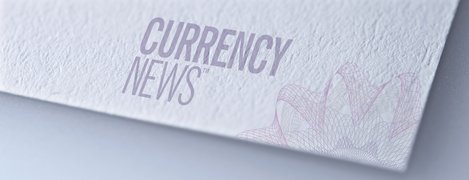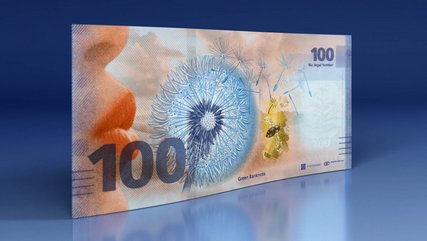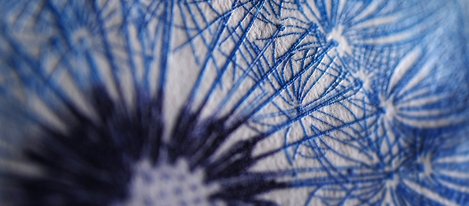

The Green Banknote – Sustainability at every level
Giesecke+ Devrient launched its Green Banknote Initiative earlier this year. The aim is to involve the currency community in working together to ensure that banknotes based on natural fibres are making cash a greener payment system by applying the principles of the circular economy, decreasing emissions in the complete cash cycle and driving resource efficiency across global value chains and operations.
At the Global Currency Forum, it followed this up with the presentation of the Green Banknote - a physical token of this initiative printed on Hybrid ADDvance® that, it says, has a core with a green and minimal use of plastic, without comprising durability or security.
So while the Green Banknote has the same look and feel, and security features, of a conventional banknote, the use of ecological, resource-saving materials and production processes serve as blueprint for what can be achieved in sustainability.
According to Felix Ehrtmann, G+D’s Product Manager Integration + Print, the Green Banknote is a contribution to a more sustainable future and higher public acceptance for cash as a preferred means of payment’. Currency News™ spoke to him to find out more.
Q: Following the Green Banknote Initiative launched this spring, G+D has now presented the Green Banknote. Why?
A: Because the Green Banknote is an integral part of our Green Banknote Initiative; it fits seamlessly into the concept of ‘durability+’ and thus demonstrates not only what is already possible, but also what kind of actions will result from it in the future. In other words, we are taking the product – the banknote – to a higher level by working with new types of locally grown fibres, certified organic cotton and recycled materials, by optimising the use of innovative products, or by using environmentally friendly printing inks. At the same time, however, we are proving that we not only see and analyse potential for improvement, but can also implement it with our existing processes – without having to reinvent the basic concept or, for example, foil-based security features from scratch.
Q: So would you say that, in addition to the virtual platform of the Green Banknote Initiative, the note itself makes sustainability ‘tangible’ in the literal sense of the word?
A: Yes, we make it tangible, concrete, and applicable. But above all: doable! There are plenty of nice ideas and empty phrases, greenwashing and greenbashing out there. For us, on the other hand, it was always a clear prerequisite that we could run our Green Banknote through our standard processes and aggregates. And that the demand for more sustainability is met.
Q: What does the Green Banknote achieve?
A: For the first time ever in banknotes, the carrier foil for the security thread and the security patch are made of 70% recycled polyester from post-consumer recycled materials such as PET bottles. Further, we have reduced the foil thickness for the protective layer in the Hybrid™ substrate from 6μm to 4μm, that is, about one-tenth of a human hair. This leads to 86% less plastic compared to banknotes made from polymer. In addition, for the first time, mineral oil-free printing inks are used, with a corresponding reduction in the use of fossil raw materials and increase of the bio-based content.And finally, the Green Banknote builds on our proven Hybrid ADDvance concept.

Q: Which means?
A: We continue to use a core based on natural renewable fibres, which – and this is completely new – consists of 50% cotton from certified sources of organic cultivation and 50% European grown fibres from FSC® (FSC-C138716) certified wood pulp from responsible forestry. This leads to a massive reduction of carbon emissions compared to conventional cotton fibres. In combination with the thin lamination film which protects the paper core but also the security foils and threads, the Green Banknote achieves the same lifespan as polymer banknotes.Moreover, alternative European grown natural fibres such as hemp were also successfully tested, which can be used in Hybrid with a high proportion of up to 50%.
Q: What were the biggest challenges?
A: The Green Banknote is a highly complex, demanding product in terms of production and materials – from the paper core to the application of the patch to the lamination process and the various printing steps. But despite the complexity, the results are impressive, generating 29% less CO2 than finished polymer banknotes. At the same time, the circulation performance will be similar to the company’s standard Hybrid banknotes, offering the same lifespan as polymer banknotes. Meanwhile, the security benefits of fibre-based substrates are retained. For example, the Green Banknote can be equipped with all state-of-the-art substrate embedded security features such as the RollingStar® i+ security thread.
Q: And what about recycling – one of the five ‘R’s of sustainability?
A: Recyling is uppermost. Products are already being created from polymer waste (such as furniture or disposable plant pots). But we can ‘upcycle’ by creating security threads and patches for banknotes from used plastic bottles, for example. From a recyclate, we thus create something with far greater value and, with the Green Banknote, make a decisive contribution to greater environmental protection and sustainability. This not only meets the demand for ‘less plastic’, but supports our customers and partners on their way to green banking.

Weitere Informationen
The Green Banknote Initiative
Als ein führendes Unternehmen der Branche nehmen wir das Thema Nachhaltigkeit ernst. Auf der Grundlage einer Studie, die Banknotensubstrate unter die Lupe genommen hat, haben wir unseren Fokus auf das Thema nachhaltige Banknoten ausgeweitet.